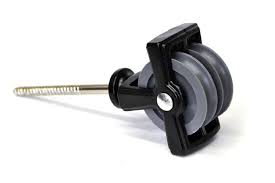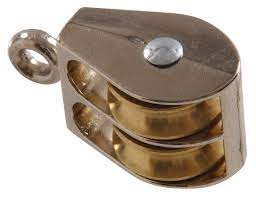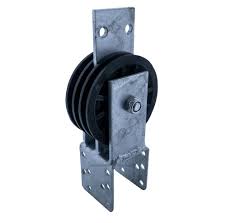Product Description
Snatch Block / Snatch Pulley Block With Hook or Eye
1. Material lifting equipment
2. High quality drop forged steel
3. Safety factor of snatch block: 4: 1
4. Hook (hs type) or eye (es type)
5. Capacity of snatch block: 0.5t~10t
6. Optional: Single wheel or double wheel
7. Sheave diameter: 75-350mm
8. Wire rope diameter: 8-28mm
9. Popular in Europe, Middle-East, North America, South America, & etc
Features of Snatch Block:
1. Durable powder coat finish
2. Heavy-duty permits to perform under extreme condition.
3. Rated loads is from 2MT to 50MT.
4. Safety factor: 4 times.
5.200% over load capacity test 1 by 1 before package.
6. Manufactured according to ISO9001 quality standard
7. CE and GS approved.
All our activities are accredited to ISO 9001 and based on delivering the highest quality possible, both in products and services, ensuring long-term benefits and optimum performance. Also we got the below certification: CE GS SUV, LR ABS ( anchors and anchor chains) Our rigging hardware is manufactured under exceptional quantity control and strictly adhered to the US, DIN, JIS, BS and AS standards.
About sample:
Cost with free If the quantity small, and the express charge account into buyer’s, after receiving the official order, the seller deducts it in first order’s
Please do not hesitate to contact us, should there be any questions or enquires.
—————-FAQ————–
Q1: Does your workshop have products in stock?
A1: Yes, we have. But we only have standard-sized products; if you need customized products, it will take some time to manufacture them.
Q2: Whether you can offer customized service?
A2: Yes, the working condition of every customer is different. All of our products can be customized depending on customers’ requirements. Please give us the information as straightforward as you can, so we can provide our best design to suit your demands.
Q3: How to confirm the working class of the crane?
A3: Please offer us the working environment, working duration, and frequency of the crane, and our engineer shall calculate it for you.
Q4: What kind of package for the hoist?
A4: Hoists and Electricals packed in wooden fumigation box. The main beams are covered by woven plastic cloth.
Q5: What kind of assistance can you offer with equipment installation?
A5: We have a professional installation team who has gone to many countries to assist with the installation. If you need us to send a technician to your factory, please let us know.
Q6: What payment terms can you accept?
A6: Our also supports L/C, D/A, D/P, T/T, Western Union, and MoneyGram payments. For example, FOB HangZhou, CIF, DDU, EX WORKS, etc.
| Type: | Pulley |
|---|---|
| Material: | Stainless Steel |
| Number of sheaves: | 1 |
| Control: | Manual |
| Color: | Blue |
| Application: | Double Beam Crane, Gantry Crane, Bridge Crane, Tower Crane, Single Grinder Crane, Lifting Platform, Small Crane |
| Samples: |
US$ 15/Piece
1 Piece(Min.Order) | |
|---|
| Customization: |
Available
| Customized Request |
|---|
How do double pulleys enhance the lifting and load-handling capabilities of machinery?
Double pulleys are a valuable component in machinery that enhances lifting and load-handling capabilities by providing mechanical advantage. Here’s a detailed explanation of how double pulleys achieve this:
1. Mechanical Advantage:
– Double pulleys utilize the concept of mechanical advantage to increase the lifting capacity and reduce the effort required to lift heavy loads. The mechanical advantage is achieved through the use of multiple sheaves or wheels within the pulley system.
2. Distribution of Load:
– With a double pulley setup, the load is distributed between two sections of the rope or cable. This distribution of load effectively reduces the strain on each section, allowing for a greater overall lifting capacity. By sharing the load, double pulleys enable the machinery to handle heavier loads than a single pulley system.
3. Increased Rope Length:
– Double pulleys also increase the effective length of the rope or cable used in the lifting mechanism. As the rope passes through the double pulley system, it travels a longer distance compared to a single pulley setup. The increased rope length translates into a greater range of movement and lifting capability for the machinery.
4. Directional Changes:
– Double pulleys offer the advantage of changing the direction of the applied force. By redirecting the pulling or lifting force, machinery can navigate complex paths or reach difficult-to-access areas. This directional flexibility enhances the versatility and maneuverability of the equipment when handling loads.
5. Smooth and Controlled Movement:
– Double pulleys facilitate smooth and controlled movement of the load. The multiple sheaves reduce friction and distribute the load evenly, resulting in a more stable and controlled lifting operation. This feature is particularly beneficial when precision and delicate handling of the load are required.
6. Versatility and Adaptability:
– Double pulleys can be incorporated into various types of machinery and equipment, offering versatility and adaptability. They can be integrated into cranes, hoists, winches, and other lifting systems. The ability to customize the configuration and arrangement of double pulleys allows machinery to be tailored to specific lifting requirements and load capacities.
7. Combination with Other Systems:
– Double pulleys can be combined with other mechanisms, such as gears or levers, to further enhance the lifting and load-handling capabilities of machinery. These combinations enable the amplification of force and provide additional mechanical advantages, allowing for the handling of even heavier loads.
Overall, double pulleys significantly enhance the lifting and load-handling capabilities of machinery by utilizing mechanical advantage, distributing the load, increasing rope length, enabling directional changes, facilitating smooth movement, and offering versatility in design and combination with other systems. The incorporation of double pulleys in machinery enhances efficiency, productivity, and safety in various industries and applications.
How are double pulleys customized for specific load-bearing requirements?
Double pulleys can be customized to meet specific load-bearing requirements in various applications. Here is a detailed explanation of how double pulleys are customized for specific load-bearing requirements:
1. Material Selection:
– To customize double pulleys for specific load-bearing requirements, the selection of appropriate materials is crucial. Pulleys can be made from various materials such as steel, aluminum, brass, or high-strength polymers. The choice of material depends on factors such as the expected load capacity, environmental conditions, weight restrictions, and desired durability. For heavy-duty applications, pulleys made from robust materials with high load-bearing capacities are selected, while lightweight materials may be suitable for lighter loads or applications where weight is a concern.
2. Size and Diameter:
– The size and diameter of double pulleys are customized based on the specific load-bearing requirements. Larger pulleys tend to have higher load-bearing capacities due to their increased surface area and ability to accommodate thicker ropes or cables. Smaller pulleys, on the other hand, are suitable for lighter loads or applications where space constraints exist. The diameter of the pulley also affects the mechanical advantage and the force required to lift the load. By selecting the appropriate size and diameter, the pulleys can be optimized for the desired load-bearing capacity.
3. Bearing Type and Efficiency:
– Double pulleys can be customized by selecting the appropriate bearing type and efficiency. Bearings reduce friction between the pulley axle and its housing, allowing for smoother rotation and efficient load handling. Common bearing types used in pulleys include ball bearings, roller bearings, and plain bearings. The choice of bearing type depends on factors such as the expected load, rotational speed, and environmental conditions. Higher-quality bearings with better efficiency are often selected for heavy-load applications or situations where precise and smooth movement is required.
4. Pulley Configuration:
– The configuration of double pulleys can be customized to meet specific load-bearing requirements. Different arrangements, such as fixed pulley, movable pulley, compound pulley, or multiple blocks, provide varying mechanical advantages and load-bearing capacities. The number of pulleys, the combination of fixed and movable pulleys, and the arrangement of the supporting strands can all be tailored to optimize the system for the desired load-bearing capacity. The pulley configuration is determined based on factors such as the weight of the load, the force required for lifting, and the desired lifting efficiency.
5. Load Distribution and Rope/Cable Selection:
– In a double pulley system, load distribution and the selection of appropriate ropes or cables are vital for meeting specific load-bearing requirements. The load needs to be evenly distributed among the supporting strands to ensure balanced load sharing and prevent overloading of individual ropes or cables. The selection of ropes or cables depends on factors such as their tensile strength, flexibility, and resistance to abrasion or environmental conditions. High-strength ropes or cables with suitable load-bearing capacities are chosen to withstand the expected loads and ensure safe and reliable operation.
6. Safety Considerations:
– Customization of double pulleys for specific load-bearing requirements also includes incorporating safety features and considerations. This may involve the addition of features such as locking mechanisms, safety catches, or overload protection systems to prevent accidents or equipment failures due to excessive loads. Safety factors, such as the design and load ratings, are carefully considered to ensure that the pulleys can handle the intended loads without compromising safety.
In summary, double pulleys can be customized for specific load-bearing requirements through material selection, size and diameter optimization, bearing type and efficiency, pulley configuration, load distribution, rope or cable selection, and incorporating necessary safety considerations. By customizing these aspects, double pulleys can be tailored to handle different load capacities, meet application-specific needs, and ensure safe and efficient load handling operations.
What is a double pulley, and how does it function in mechanical systems?
A double pulley, also known as a block and tackle or a two-sheave pulley, is a type of pulley system that consists of two pulleys mounted on a common axle or frame. It is designed to enhance mechanical advantage and facilitate the lifting or pulling of heavy loads with reduced effort. Here is a detailed explanation of how a double pulley functions in mechanical systems:
A double pulley operates on the principle of distributing the load between multiple strands of rope or cable. The pulley system consists of an upper pulley, known as the fixed or anchor pulley, and a lower pulley, known as the movable or load pulley. The rope or cable passes over the upper pulley, then down and around the lower pulley, creating multiple strands of rope between the pulleys.
The mechanical advantage provided by a double pulley system arises from the increased length of rope or cable that must be pulled to lift the load. When a force is applied to the free end of the rope, it creates tension in the rope, which is transmitted to both sides of the pulley system. As the rope passes over the fixed pulley, the tension in the rope is divided equally between the two sides. This distribution of tension allows for a reduction in the force required to lift the load.
The mechanical advantage of a double pulley system can be further enhanced by adding additional pulleys and strands of rope. For example, a triple pulley system consists of three pulleys and two strands of rope, while a quadruple pulley system consists of four pulleys and three strands of rope. Each additional pulley and strand of rope increases the mechanical advantage, enabling even heavier loads to be lifted with relatively less effort.
In a double pulley system, the load can be lifted by pulling on either the free end of the rope or the movable pulley itself. Pulling the free end of the rope requires a longer length of rope to be pulled, resulting in a greater mechanical advantage but requiring more rope to be accommodated. Pulling the movable pulley directly requires a shorter length of rope to be pulled, reducing the mechanical advantage but requiring less rope. The choice of pulling method depends on the specific requirements of the application.
Double pulley systems are commonly used in various applications, including construction, rigging, and hoisting. They provide several advantages:
1. Mechanical Advantage:
– The primary function of a double pulley system is to provide mechanical advantage, allowing for the lifting or pulling of heavy loads with reduced effort. By distributing the load between multiple strands of rope, the system effectively reduces the force required to overcome the load’s weight.
2. Increased Stability:
– The use of multiple strands of rope in a double pulley system improves stability during lifting or pulling operations. The load is evenly distributed between the strands, reducing the risk of slippage or imbalance. This increased stability enhances safety and control in mechanical systems.
3. Versatility:
– Double pulley systems can be designed to accommodate various rope or cable types, making them versatile for different applications. They can be used with synthetic ropes, steel cables, or even chains, depending on the load requirements and environmental conditions.
4. Adjustable Lifting Speed:
– The movable pulley in a double pulley system allows for adjustable lifting speed. By pulling the free end of the rope, the lifting speed can be increased. Conversely, pulling the movable pulley directly reduces the lifting speed. This adjustability enables precise control over lifting operations.
5. Compact Design:
– Despite providing mechanical advantage, double pulley systems have a relatively compact design. They require less space compared to other lifting mechanisms, making them suitable for applications with limited overhead clearance or confined spaces.
In summary, a double pulley, or block and tackle system, functions by distributing the load between multiple strands of rope to provide mechanical advantage. It reduces the force required to lift or pull heavy loads, offers increased stability, allows for adjustable lifting speed, and features a compact design. These characteristics make double pulley systems valuable in various mechanical applications that involve lifting, rigging, or hoisting.
editor by CX
2023-12-01




